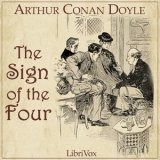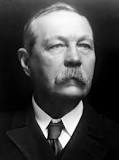The Sign of the Four Page #12
The Sign of the Four, also called The Sign of Four, is the second novel featuring Sherlock Holmes written by Sir Arthur Conan Doyle. Doyle wrote four novels and 56 short stories featuring the fictional detective.
He held down the lamp to the floor, and as he did so I saw for the second time that night a startled, surprised look come over his face. For myself, as I followed his gaze my skin was cold under my clothes. The floor was covered thickly with the prints of a naked foot,--clear, well defined, perfectly formed, but scarce half the size of those of an ordinary man. "Holmes," I said, in a whisper, "a child has done the horrid thing." He had recovered his self-possession in an instant. "I was staggered for the moment," he said, "but the thing is quite natural. My memory failed me, or I should have been able to foretell it. There is nothing more to be learned here. Let us go down." "What is your theory, then, as to those footmarks?" I asked, eagerly, when we had regained the lower room once more. "My dear Watson, try a little analysis yourself," said he, with a touch of impatience. "You know my methods. Apply them, and it will be instructive to compare results." "I cannot conceive anything which will cover the facts," I answered. "It will be clear enough to you soon," he said, in an off-hand way. "I think that there is nothing else of importance here, but I will look." He whipped out his lens and a tape measure, and hurried about the room on his knees, measuring, comparing, examining, with his long thin nose only a few inches from the planks, and his beady eyes gleaming and deep-set like those of a bird. So swift, silent, and furtive were his movements, like those of a trained blood-hound picking out a scent, that I could not but think what a terrible criminal he would have made had he turned his energy and sagacity against the law, instead of exerting them in its defense. As he hunted about, he kept muttering to himself, and finally he broke out into a loud crow of delight. "We are certainly in luck," said he. "We ought to have very little trouble now. Number One has had the misfortune to tread in the creosote. You can see the outline of the edge of his small foot here at the side of this evil-smelling mess. The carboy has been cracked, You see, and the stuff has leaked out." "What then?" I asked. "Why, we have got him, that's all," said he. "I know a dog that would follow that scent to the world's end. If a pack can track a trailed herring across a shire, how far can a specially-trained hound follow so pungent a smell as this? It sounds like a sum in the rule of three. The answer should give us the--But halloo! here are the accredited representatives of the law." Heavy steps and the clamor of loud voices were audible from below, and the hall door shut with a loud crash. "Before they come," said Holmes, "just put your hand here on this poor fellow's arm, and here on his leg. What do you feel?" "The muscles are as hard as a board," I answered. "Quite so. They are in a state of extreme contraction, far exceeding the usual rigor mortis. Coupled with this distortion of the face, this Hippocratic smile, or 'risus sardonicus,' as the old writers called it, what conclusion would it suggest to your mind?" "Death from some powerful vegetable alkaloid," I answered,--"some strychnine-like substance which would produce tetanus." "That was the idea which occurred to me the instant I saw the drawn muscles of the face. On getting into the room I at once looked for the means by which the poison had entered the system. As you saw, I discovered a thorn which had been driven or shot with no great force into the scalp. You observe that the part struck was that which would be turned towards the hole in the ceiling if the man were erect in his chair. Now examine the thorn." I took it up gingerly and held it in the light of the lantern. It was long, sharp, and black, with a glazed look near the point as though some gummy substance had dried upon it. The blunt end had been trimmed and rounded off with a knife. "Is that an English thorn?" he asked. "No, it certainly is not." "With all these data you should be able to draw some just inference. But here are the regulars: so the auxiliary forces may beat a retreat." As he spoke, the steps which had been coming nearer sounded loudly on the passage, and a very stout, portly man in a gray suit strode heavily into the room. He was red-faced, burly and plethoric, with a pair of very small twinkling eyes which looked keenly out from between swollen and puffy pouches. He was closely followed by an inspector in uniform, and by the still palpitating Thaddeus Sholto. "Here's a business!" he cried, in a muffled, husky voice. "Here's a pretty business! But who are all these? Why, the house seems to be as full as a rabbit-warren!" "I think you must recollect me, Mr. Athelney Jones," said Holmes, quietly. "Why, of course I do!" he wheezed. "It's Mr. Sherlock Holmes, the theorist. Remember you! I'll never forget how you lectured us all on causes and inferences and effects in the Bishopgate jewel case. It's true you set us on the right track; but you'll own now that it was more by good luck than good guidance." "It was a piece of very simple reasoning." "Oh, come, now, come! Never be ashamed to own up. But what is all this? Bad business! Bad business! Stern facts here,--no room for theories. How lucky that I happened to be out at Norwood over another case! I was at the station when the message arrived. What d'you think the man died of?" "Oh, this is hardly a case for me to theorize over," said Holmes, dryly. "No, no. Still, we can't deny that you hit the nail on the head sometimes. Dear me! Door locked, I understand. Jewels worth half a million missing. How was the window?" "Fastened; but there are steps on the sill." "Well, well, if it was fastened the steps could have nothing to do with the matter. That's common sense. Man might have died in a fit; but then the jewels are missing. Ha! I have a theory. These flashes come upon me at times.--Just step outside, sergeant, and you, Mr. Sholto. Your friend can remain.--What do you think of this, Holmes? Sholto was, on his own confession, with his brother last night. The brother died in a fit, on which Sholto walked off with the treasure. How's that?" "On which the dead man very considerately got up and locked the door on the inside." "Hum! There's a flaw there. Let us apply common sense to the matter. This Thaddeus Sholto WAS with his brother; there WAS a quarrel; so much we know. The brother is dead and the jewels are gone. So much also we know. No one saw the brother from the time Thaddeus left him. His bed had not been slept in. Thaddeus is evidently in a most disturbed state of mind. His appearance is--well, not attractive. You see that I am weaving my web round Thaddeus. The net begins to close upon him." "You are not quite in possession of the facts yet," said Holmes. "This splinter of wood, which I have every reason to believe to be poisoned, was in the man's scalp where you still see the mark; this card, inscribed as you see it, was on the table; and beside it lay this rather curious stone-headed instrument. How does all that fit into your theory?"
Translation
Translate and read this book in other languages:
Select another language:
- - Select -
- 简体中文 (Chinese - Simplified)
- 繁體中文 (Chinese - Traditional)
- Español (Spanish)
- Esperanto (Esperanto)
- 日本語 (Japanese)
- Português (Portuguese)
- Deutsch (German)
- العربية (Arabic)
- Français (French)
- Русский (Russian)
- ಕನ್ನಡ (Kannada)
- 한국어 (Korean)
- עברית (Hebrew)
- Gaeilge (Irish)
- Українська (Ukrainian)
- اردو (Urdu)
- Magyar (Hungarian)
- मानक हिन्दी (Hindi)
- Indonesia (Indonesian)
- Italiano (Italian)
- தமிழ் (Tamil)
- Türkçe (Turkish)
- తెలుగు (Telugu)
- ภาษาไทย (Thai)
- Tiếng Việt (Vietnamese)
- Čeština (Czech)
- Polski (Polish)
- Bahasa Indonesia (Indonesian)
- Românește (Romanian)
- Nederlands (Dutch)
- Ελληνικά (Greek)
- Latinum (Latin)
- Svenska (Swedish)
- Dansk (Danish)
- Suomi (Finnish)
- فارسی (Persian)
- ייִדיש (Yiddish)
- հայերեն (Armenian)
- Norsk (Norwegian)
- English (English)
Citation
Use the citation below to add this book to your bibliography:
Style:MLAChicagoAPA
"The Sign of the Four Books." Literature.com. STANDS4 LLC, 2025. Web. 23 Jan. 2025. <https://www.literature.com/book/the_sign_of_the_four_100>.




Discuss this The Sign of the Four book with the community:
Report Comment
We're doing our best to make sure our content is useful, accurate and safe.
If by any chance you spot an inappropriate comment while navigating through our website please use this form to let us know, and we'll take care of it shortly.
Attachment
You need to be logged in to favorite.
Log In